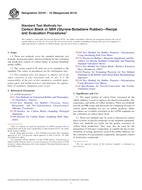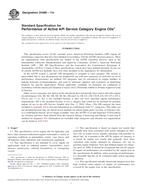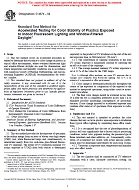1.1 This test method covers the laboratory determination of the rate at which organic biocide is released from an antifouling coating exposed in substitute ocean water. The test is run entirely in the laboratory under controlled conditions of pH, temperature, salinity, and hydrodynamics. Analytical procedures are provided for the determination of the release rate of 4,5-dichloro-2-n-octylisothiazolin-3-one (DCOIT), zinc and copper pyrithione (ZPT and CuPT), and N-cyclopropyl-N-(1,1-dimethylethyl)-6-(methylthio)-1,3,5-triazine-2,4-diamine (CDMTD). At predetermined intervals, substitute ocean water samples are analyzed for leached biocide using a suitable analytical technique.
1.2 In cases in which the antifouling coating contains both an organic biocide and a copper-based biocide, the release rate of copper may optionally be concurrently determined according to the procedure found in Test Method D 6442.
1.3 The procedure contains the preparation steps for the determination of the release rate of biocide in substitute ocean water from antifouling paints including apparatus, reagents, holding tank conditions, and sampling point details. The procedure calls for the accurate determination of organic biocide concentrations in substitute ocean water at the low g L-1 (parts per billion, ppb) level. To detect and correct for reagent impurities and allow a suitable level of analytical precision to be achieved, the analytical method to be used for the determination of the concentration of organic biocide in substitute ocean water must meet the acceptability criteria given in Annex A2. Where Annex A2 specifies a limit of quantitation (LOQ), the procedure for determining the LOQ for the organic biocide in substitute ocean water by the analytical method presented in is to be followed.
1.4 Suitable analytical methods that use high-performance liquid chromatography (HPLC) for determining the concentration of DCOIT, ZPT and CuPT, and CDMTD in substitute ocean water are given in Appendix X1-Appendix X3, respectively. Other methods may be used provided that they meet the appropriate criteria given in Annex A2.
1.5 When the release rate of a highly photosensitive organic biocide is being determined, steps must be taken to protect the apparatus and samples from exposure to natural and artificial visible light sources. Any such requirement for these steps to be taken for a particular biocide is indicated in Annex A2.
1.6 The practical limits for quantifying biocide release rates by this method are from 4.5 to 500 g cm-2 d -1 for DCOIT, 0.36 to 500 g cm-2 d-1 for CuPT, 0.36 to 500 g cm-2 d-1 for ZPT, and 2.7 to 500 g cm-2 d-1 for CDMTD. These ranges may be extended to 3.8 to 500 g cm-2 d -1 for DCOIT, 0.16 to 500 g cm-2 d-1 for CuPT, 0.2 to 500 g cm-2 d-1 for ZPT, and 2.2 to 500 g cm-2 d-1 for CDMTD if the procedures described in (as appropriate) are followed. The quantitation of release rates lower than these ranges will require the use of analytical methods with lower limits of quantitation than those specified in Annex A2.
1.7 The results of this test method do not reflect environmental biocide release rates for antifouling products, and are not suitable for direct use in the process of generating environmental risk assessments, environmental loading estimates, or for establishing release rate limits for regulatory purposes. See also Section 4.
1.8 The values stated in SI units are to be regarded as the standard. The values given in parentheses are for information only.
1.9 This standard does not purport to address all of the safety concerns, if any, associated with its use. It is the responsibility of the user of this standard to establish appropriate safety and health practices and determine the applicability of regulatory limitations prior to use.
Product Details
- Published:
- 02/01/2007
- Number of Pages:
- 21
- File Size:
- 1 file , 260 KB


